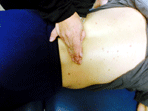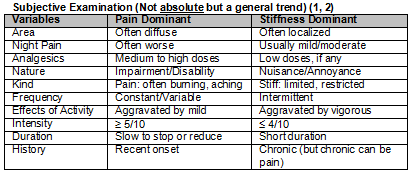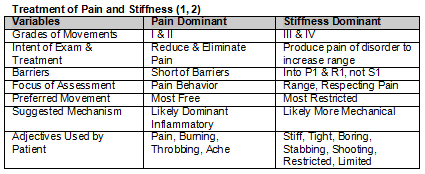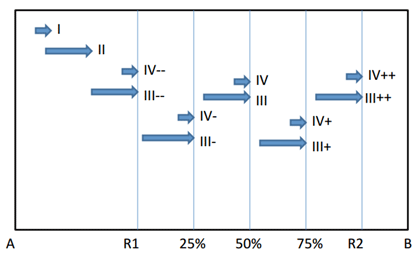|

Joint mobilizations are one of many
tools utilized by physical therapists to treat various conditions at
various joints. According to Maitland, patient’s can be categorized
into two categories – pain dominant and stiffness dominant. This
categorization can assist with determining which grade of
mobilizations should be performed on the affected area of the
patient. Through the subjective and physical examination, a
therapist can usually determine which type of patient they may be
dealing with:


Once a determination is made on whether
a patient is pain or stiffness dominant through both the subjective
and physical exams a treatment plan can be developed (see chart
below).

Maitland categorizes grades of movement
by the following (1, 2):
• Grade I small amplitude, short of resistance
• Grade II Large amplitude, short of resistance
• Grade III Large amplitude to 50% of R1 – R2
• Grade IV Small amplitude to 50% of R1 - R2
• Grade V Small amplitude, high velocity thrust at end of available
range
* R1 = Defined as the first
perceptible onset of resistance which varies from area to area
* R2 = Limit of Resistance
Maitland further refines the grades of movements above with pluses
and minuses (1, 2):
• III- - or IV- - are taken to the first onset of R1
• III- or IV- are taken to 25% of R1-R2
• III+ or IV+ are taken to 75% of R1-R2
• III++ or IV++ are taken to max R or end of range

Despite which grade of mobilization is utilized in the treatment,
the Maitland method emphasizes “assessment” when working with the
patient. The assessment should be conducted throughout the entire
process ie. at the initial evaluation, after the initial evaluation,
during the performance of a technique, after the application of a
technique, at the end of the treatment session, at the beginning of
the next treatment session, retrospectively and continuously (1, 2).
For additional information on manual therapy, joint mobilization and
the Maitland approach please visit
www.ozpt.com.
Last revised: October 30, 2015
by Chai Rasavong, MPT, COMT, MBA
References
1) Maitland Australian Physiotherapy Seminars MT – 1 Basic
Peripheral
2) Maitland Australian Physiotherapy Seminars MT – 2 Basic Spinal
|











